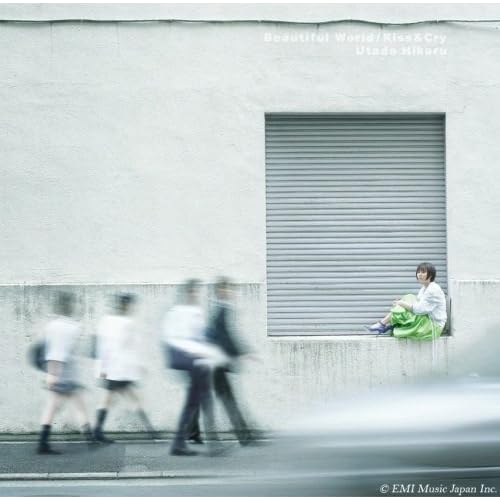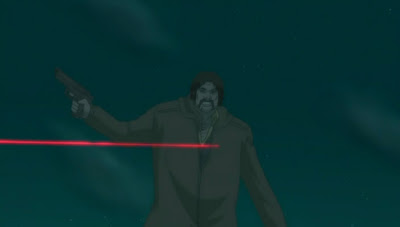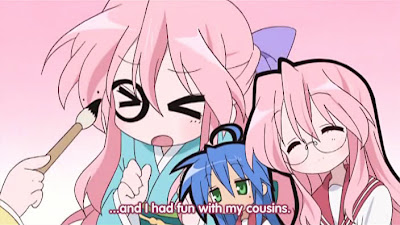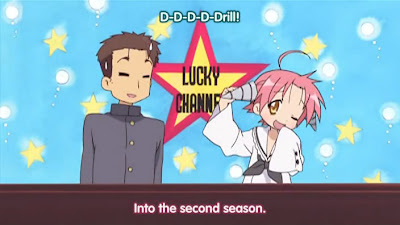All good lies contain a hint of truth. Hitohira weaves the stage into the world outside of it that simply pulls in the viewer. It's not surreal so much as it's reality exaggerated. And sometimes, there is no suspension of disbelief required.
 Presenting Exhibit A
Presenting Exhibit AEven if it was brief, Nono's indiscriminate use of her acting skills to bring terror upon her
foes friends others was a great tie-in. Contrast this to Mugi's inability to act her way out of having to go to practice.
 Introducing the N-1000
Introducing the N-1000Structurally,
Hitohira could have, should have, ended at episode 11. The series isn't worse off because of episode 12, but episode 11 was a high note whereas episode 12 meandered and felt awkward, especially in the second half.
On dreamsFirst
Planetes, and to a (much) lesser extent
Moonlight Mile, and now
Hitohira.
Moonlight Mile is actually pretty pragmatic, with little in the way of moral dilemmas, while
Planetes deliberates much upon the cost of dreams from the perspective of the dreamer.
Hitohira is all about how to come to terms with the dreamer and the hurt that they cause, real or imagined.
The Mirei-Nono dynamic is more straightforward to comprehend than Mugi-Kayo, partly owing to the fact that it's much more severe. Mirei acts partly out of guilt — even though the cause of Nono's condition is never known — and partly out of fear of the unknown. Nono will likely require
surgery in the future, as her condition worsened prior to the performance. She could wind up with a breathing tube in her throat for the rest of her life.
Who is being inconsiderate here? Nono, who would and does lay it on the line for one last shot at stage acting? Or Mirei, for interfering in Nono's business and attempting to deny her free will?
The series has an answer, and it's an unsatisfactory one to me, in the case of Nono, but one that is perfectly fine for Mugi.
Not everyone can be a Hachimaki or Locksmith and put their own dreams ahead of others. Kayo apparently struggles with her dreams throughout the series, and perhaps
Hitohira warrants a re-watch in some key sections to see if there are signs of this.
I found it a bit trite that Kayo would draw support from a Mugi, on a stage, who didn't believe the words she uttered then and doesn't believe them in the immediate aftermath of the play. That aside, the problem lies with Mugi, who eventually comes to terms with the situation and lets Kayo go.
The answer, which was also embedded in the play, is common enough. Tough times are inevitable, but everyone rides them out. By extension, there's no point in hiding from them, and trying to only aggravates the pain and regret. Consequently, you should support yourself and support others.
Does it make sense, then, only because Kayo has less to lose? She's only going abroad to study; it's not as if she will never come home. She will probably do fine regardless. But what about Nono? Her scenario has more grim outcomes, and it could be (or could not be) aggravated by her acting.
Is it better to go out like a meteorite then? Live briefly but brilliantly? There is no middle ground when it comes to Nono. To go out with no regrets is great, but it's as if she has decided her voice is terminal. It's strange to think of Nono as simultaneously courageous and dignified, yet defeatist, but that's because she's so extreme in her thinking.
You may not agree with Nono (and I do not, if that wasn't clear), but she does get things done. She is better at apologizing later than seeking permission first.
On partingsI wonder at times whether the amount of emotion involved in saying goodbye is proportional to the strength of bond between those parting. Or is to be emotional just a sign of weakness and, in Mugi's case, selfishness? I should preface this question by saying that I ask about casual partings. No one's being sent to a war zone, no one's leaving a war zone.
Being the most recent, and thus most relevant, I offer the reader my university experience. I can say that it doesn't particularly pain me to part with my classmates. I made some good friends, some who will be in town, some who have had to move back home, and some who have plain left the country for work or school. I shed no tears, and I doubt they did either.
A shaking of hands. A hug. A promise to keep in touch. That's all there is to it.
What good does it do anyone to cry? It's bittersweet, yes, but is it
sad? Are we all gathered on the last day of class, or the day of convocation, to mourn the passing of our undergraduate lives? No! It's a time to celebrate new beginnings, to wish others success and exchange contact information.
I will say that I have cried when my parents told me how proud they were. It happened on two occasions, but for convocation they just wanted to know if I was going to find a job for the summer. We've all become a bit more pragmatic, I think.
Perhaps
Hitohira's message is lost on myself and those around me, but I think I will be touched by the sometimes brutally frank interactions of the characters for a while to come. I'm not sad to see it end. Rather, we'll keep in touch.
Edit: Most of the above was written having not finished the final episode. Seeing the rooftop scene made me think that perhaps Mugi did finally understand what I felt about partings. It's a big world out there, willing to accommodate everyone with a dream. It's an optimistic world, yes, but one that anyone that holds hope must believe in.
Continue Entry......
























